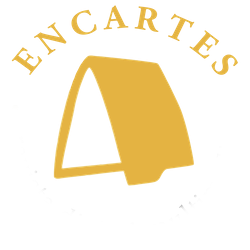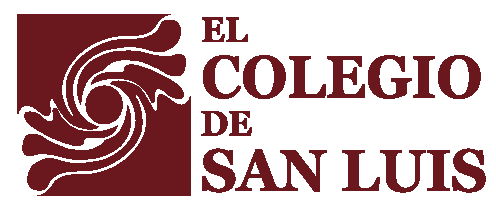Concern over the armed conflict unleashed on October 2023 in the area known as the Gaza Strip has led to mobilizations, takeovers of public spaces and performances around the world. Although it is part of a long-standing territorial conflict between two ethno-national groups, it has become a global concern for different student groups, religious, human rights and political activists who are speaking out against a war that has contravened international agreements and has increased hate speech and attacks on civil society - mainly children and women, the elderly and journalists.
During 2024, the war intensified and expanded its territorial radius beyond Palestine. This situation has given rise to multiple demonstrations that make use of ritualized symbolic expressions to demand a halt to the war and denounce the horrors it provokes. Pro-Palestinian committees have been formed in different cities to oppose the war and denounce what Amnesty International called genocide. On the other hand, tensions have also shifted to public spaces, which has led to police repression of protests.
Due to the importance of this topic in today's time, the magazine Encartes launched an open invitation to participate in the vi photography contest with images capturing objects, subjects, places, landscapes, symbols and aesthetics that have accompanied the mobilizations and demonstrations around the Israel-Palestine war conflict taking place in different universities, public squares, in front of embassies, in national festivities, in political and religious ceremonies and even in parades and other festivities.
The call stated that the images had to cover the following contents: to show the processes of aesthetic creativity that generate anti-war and anti-nationalist manifestations, denouncing violence, using not only words but also staging, installations and shots of emblematic sites and stylistic interventions of symbols, as well as the creation of an iconography of denunciation or the metaphoricity (deconstruction of signs of power) with which the conflicts of race, nation, ethnicity, territory, religion and gender are expressed.
The call was extended to visual artists, filmmakers, researchers, communities, collectives, students of social sciences and humanities to send their photographs accompanied by a descriptive title and caption data (emphasizing the event, the place where it took place, who are the participants and the date), and a short text explaining the expressive meanings of the demonstration.
The response was very good. We received 105 photographs from 21 participants. The photographs received document demonstrations around the Israel-Palestine conflict in nine different cities, showing the impact that this issue has had on a global scale: Guadalajara, Guanajuato, Mexico City, Tijuana, San Cristóbal de las Casas (Chiapas), Santiago de Chile, New York and Los Angeles (United States) and Uruguay. Due to the quality of the images and the strength of the situations they were able to capture with their cameras, it was not easy to make the selection and even less so to decide which ones would get the first places. Thus, we had to establish several criteria to make a selection of 17 photographs: first, we considered the quality of the photograph (framing, aesthetic composition, image resolution); second, we took into account the expressive force of the image (that in itself could generate a message); third, the members of the jury had in mind the narrative as a whole and tried to ensure that the photos chosen would allow us to form a visual narrative that would account for the diversity of situations, places and actors involved in the demonstrations. In this way we were forced to avoid repetition of content and to choose only one photograph when this happened. Five members of the editorial team participated in the selection committee.
We decided to award first place to Elizabeth Sauno's photograph, which shows a demonstrator depicting a Palestinian mother carrying a bloody baby in her arms. The photo was taken during the March for Palestine on December 17, 2023 in Mexico City. Second place was awarded to Rodolfo Ontiveros for the photograph "Fences" which generates the metaphor of the body as a territory lacerated by barbed wire; it was taken on September 5, 2024, during a demonstration on Paseo de la Reforma in Mexico City. We decided to award third place to two photographs: one by Charlie Eherman and the other by José Manuel Martín Pérez. The first author's depicts "Two men, a Palestinian (left) and an Orthodox Jew (right), show peace signs next to the White House in Washington D. C., USA, during a national demonstration" (June 8, 2024, Washington). The second photograph presents how the global action of solidarity with Palestine is articulated with the feminist demands that took place in the already named Plaza de la Resistencia in San Cristóbal de las Casas during the march of March 8, 2024, in the framework of International Women's Day.
Each of the four winning photographs documents a different face of the demonstrations, but, when seen together, they allow us to recognize that the shared symbols give a single voice to people of different nationalities who may not speak the same language. At the same time, they help us to recognize how their installation in different places deploys multiple enunciations, making photography a resource of metaphoricity as a productive matrix to redefine the social (Bhabha, 2011) from the pro-Palestinian demonstrations and against the war actions in the Gaza Strip.
The idea behind the photographic contests organized by Encartes seeks to assemble the images in order to generate a meta-narrative. Each image captures a different local scenario that, when put in relation, allows the narration of different realities articulated by a global aesthetic. These are articulated because they occur in the simultaneity of a historical time even though they are replicated in multiple distant places. At the same time, the singularity of each shot accounts for the multiplicity of actors, scenarios and symbolic expressions that are manifested there. The exercise allows us to circumvent the paradox of political homogeneity and heterogeneity of identity belonging.
The pro-Palestine movement is undoubtedly a transnational mobilization that has produced its own slogans and symbolism. These aesthetic marks and emblems are the lingua franca that articulates a global communitas of an imagined moral community that shares values, although they will never meet or interact face to face (Anderson, 1993); that has in common a sense of grievance and at the same time a sense of commitment. Different pro-Palestinian committees exist in different countries, cities and towns. The slogans of denunciation and symbols are shared representations and build a single voice in simultaneous time throughout the world. For example, kite flying is already an act of empathy with the children of the Palestinian people; the use or representation of the kufiya covering head and neck is already a distinctive element of the Middle East and wearing it places the enunciation of an activist body. The watermelons, whose colors match the Palestinian flag, go hand in hand with the choruses and banners of free Palestine, as do the Palestinian flags.
The interesting thing about representation is that these symbols do not appear in a vacuum: they dress bodies, they are installed in key scenarios to intervene places. The symbols have acquired a powerful metaphoricity with dissident force. For example, the kite reaches its flight in the emblematic building of the National Autonomous University of Mexico or flying over the concrete slab of Mexico City's zocalo (photo by Dzilam Méndez Villagrán). The flag is placed on the sand of a beach, metaphorically restoring the slogan "From the river to the sea" (photo by Pilar Aranda). The flag is intervened with the phrase "Nunca más, nunca nadie" and "ni un@ más" by a Jewish population that places the slogan of opposition to the holocaust on the Palestinian flag, to generate a hybrid of opposition to the war and to dissociate itself from Zionism (photos by Charlie Eherman).
The flag is used to conquer territories. Its placement constitutes representativeness in a regime of unrepresentability (Rancière, 2009). In the different photos selected, the flag generates a regime of visibility of solidarity for Palestine that, when placed in iconic places such as monuments, acquires a metaphorical enunciative power: In front of the Angel of Independence on Reforma Avenue in Mexico City (photo by Elizabeth Sauna), in front of the Glorieta de la Minerva (symbol of justice) in Guadalajara (photo by Christophe Alberto Palomera Lamas), placed on the border wall that divides Mexico and the United States today in what used to be the same territory inhabited by families that were divided by the wall (photo by Marco Vinicio Morales Muñoz). It even extends the enunciation of genocide to other realities, as is the case with the placement of the sign "Stop genocide" on the wall that divides Mexico from the United States (photo by Priscilla Alexa Macías Mojica), extending the clamor to the tightening of immigration policies. Symbols also move to occupy spaces and change their vocation, such as the emblematic Central Station in New York, taken over by demonstrators from the Jewish community (photo by Charlie Eherman); or their presence in the plaza of San Cristobal de las Casas (photo by Jose Manuel Martin Perez) with a wooden cross in the background, representing the indigenous Catholicism of the area.
The flag transgresses territorialities that also leave their territories traced by the States to configure mini-domains in other countries. This is the case of embassies. The photographs of a demonstration outside the Israeli embassy reproduce scenarios and experiences of violent confrontation (photo by Gerardo Vieyra). We see homemade bombs, police fences, fire, fallen bodies. This did not happen in Gaza, but in Mexico, in the territory of the Israeli embassy; but also in the center of Mexico City, in front of the Guardiola building, which houses the Bank of Mexico (photo by Ana Rodríguez). Territories are made by practicing them and the doors of the Guadalajara International Book Fair during the last month of November acquire the notoriety of an international forum and, therefore, of visibility beyond the local (photo by Pilar Aranda).
Symbols linked to different bodies also generate intersections between various activisms: they gain and expand the demands when they are linked to the feminist movement or when they are articulated with the demands for the recognition of transsexuals; or the resymbolization achieved by placing the already recognized mustache of Hitler, the exterminator of the Jews, on the portrait of Benjamin Netanyahu, current Prime Minister of Israel.
We invite you to sharpen your gaze to read the multiple realities generated by the aesthetic interventions in favor of Palestine captured by the lenses of photographic cameras and, at the same time, to allow yourself to enjoy the marvelous photos that make up this visual essay.
Renée de la Torre
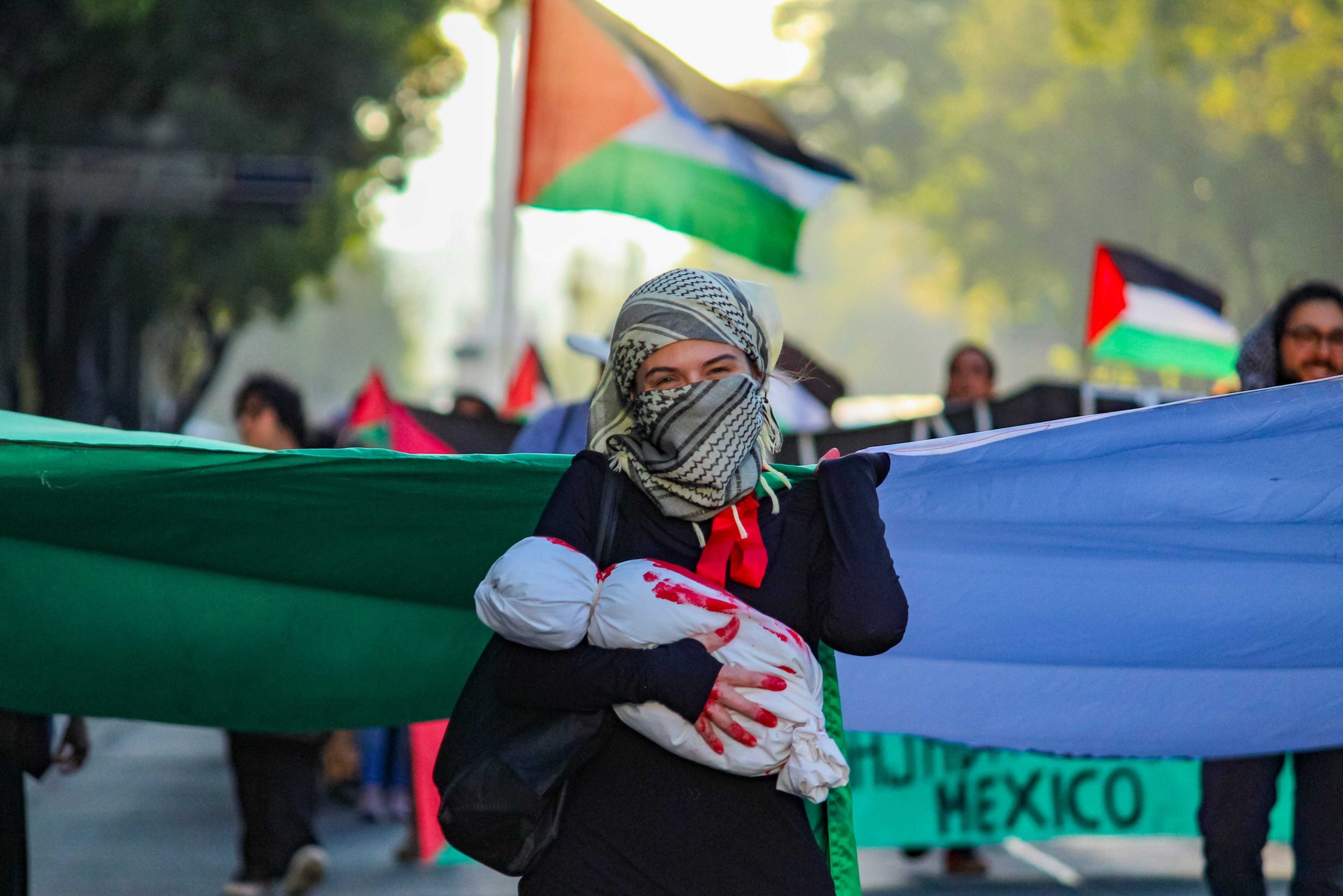
March for Palestine 17 Dec 2023 CDMX
Elizabeth Sauno, Mexico City, December 17, 2023.
Mobilization in solidarity with Palestine, from the Angel of Independence to the Zocalo, Mexico City.
Fences
Rodolfo Oliveros, Paseo de la Reforma, CDMX, September 5, 2024.
Two young men march through Palestine holding hands; the body is the territory encircled by the State of Israel.
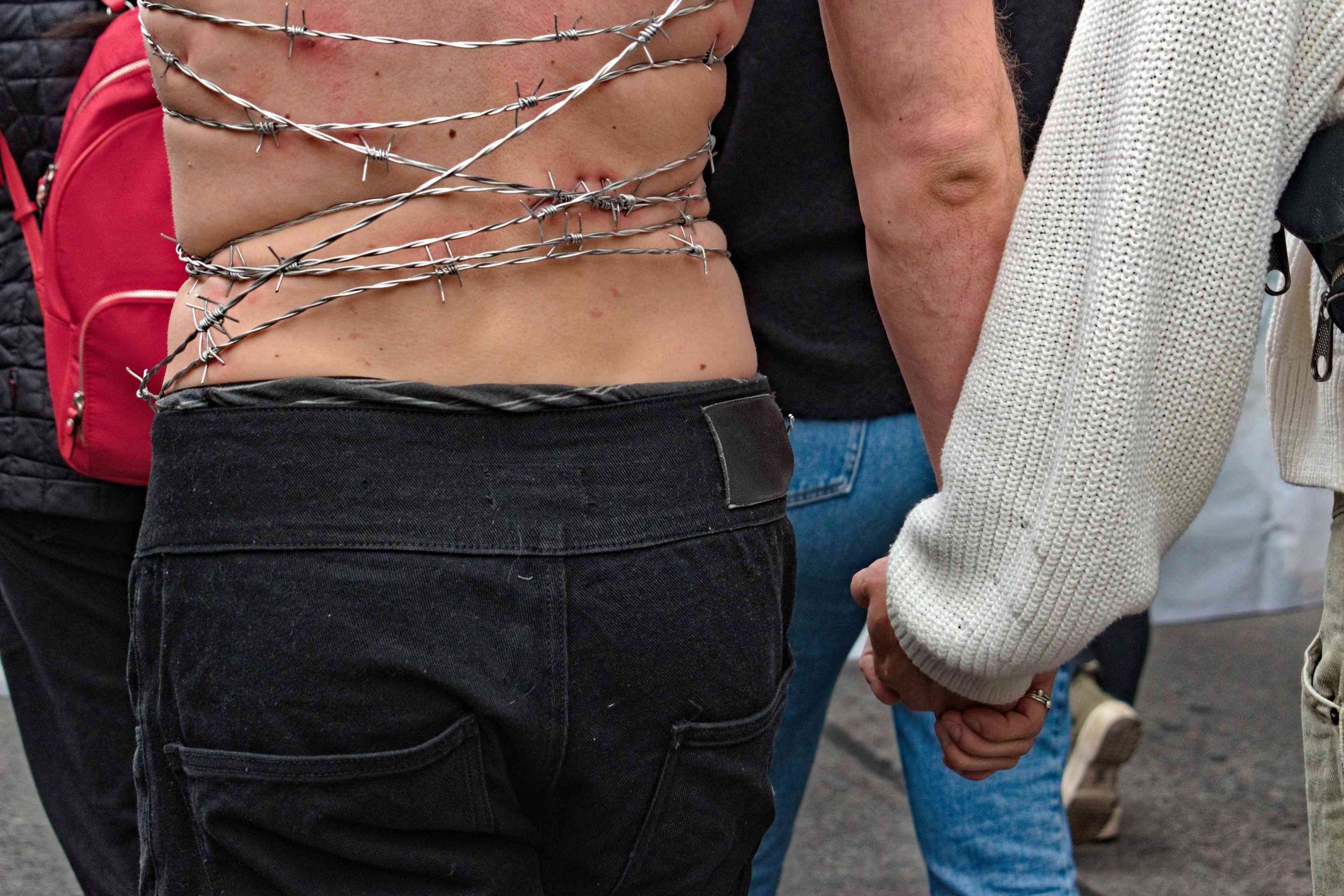

One year of genocide, 76 years of occupation.
José Manuel Martín Pérez, Plaza de la Resistencia, San Cristóbal de Las Casas, Chiapas, Mexico, March 8, 2024.
On March 8, in the framework of International Women's Day, the feminist movement in Chiapas joined the global action in solidarity with Palestine.
Symbols of peace in the capital.
Charlie Ehrman, Washington DC, June 8, 2024
Two men, a Palestinian (left) and an Orthodox Jew (right), display peace signs next to the White House in Washington DC, USA, during a national demonstration.
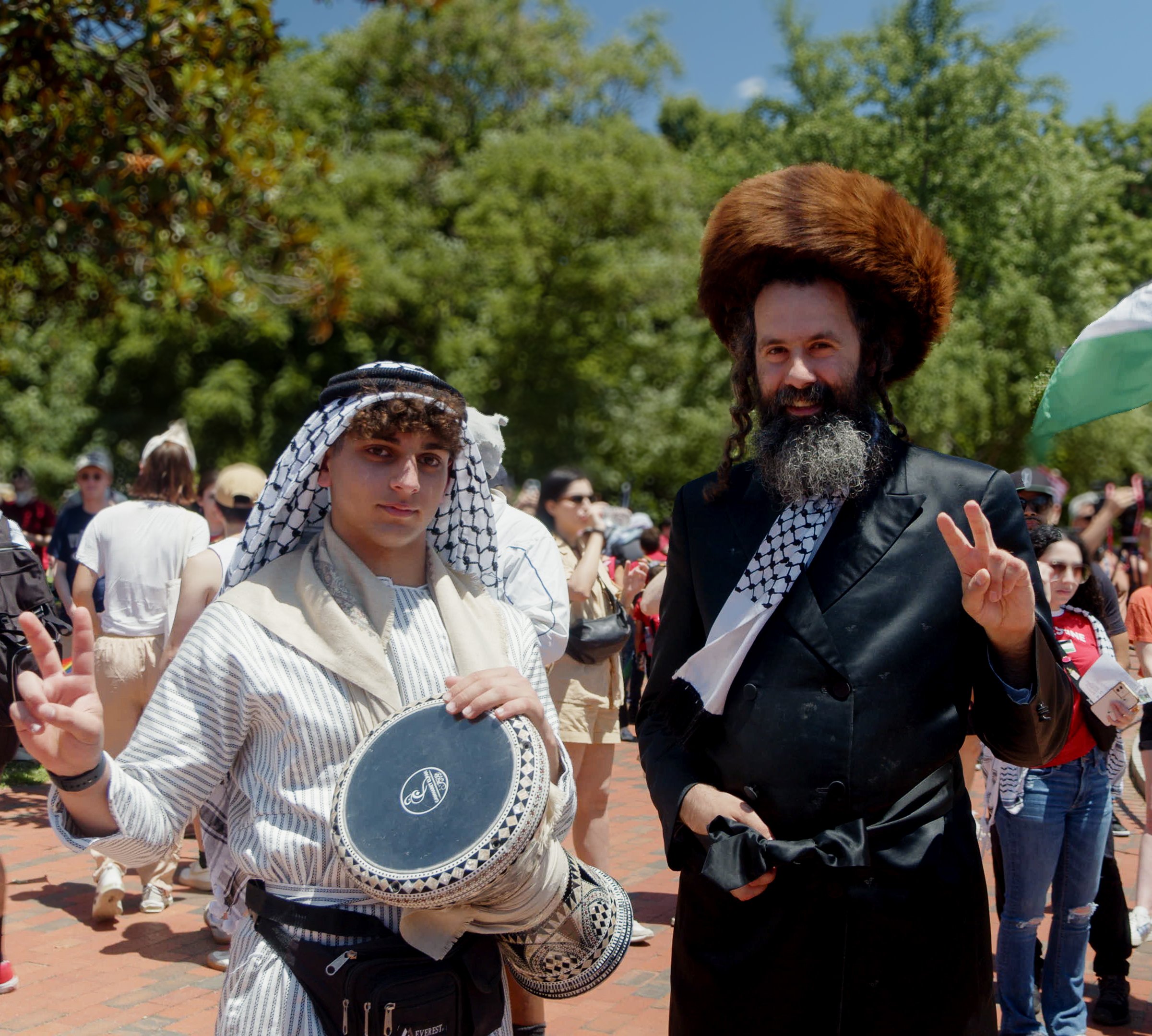
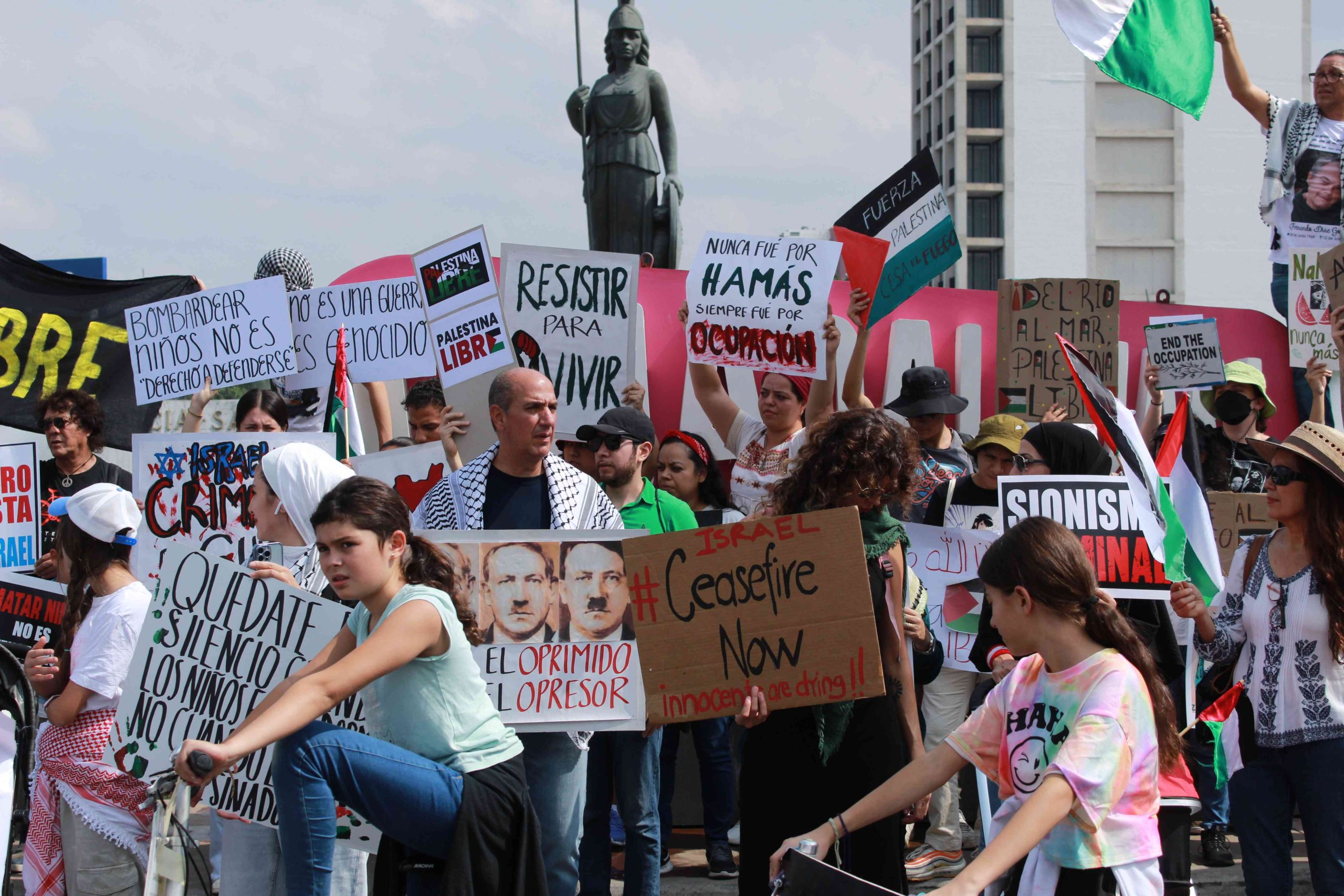
Pro-Palestinian Minerva
Christophe Alberto Palomera Lamas, Mobilization in solidarity with Palestine. Glorieta la Minerva, Guadalajara, Jalisco. Committee of Solidarity with Palestine GDL. November 12, 2023.
La Minerva, an emblematic symbol of Guadalajara, has been a meeting point to celebrate the identity of Guadalajara, but also to protest. Spectator of the search for justice and strength gives opening to the first mobilizations of the Committee of Solidarity with Palestine GDL. November 12, 2023.
Boy with kite in the Zócalo square
Dzilam Méndez Villagrán, Mexico City Zócalo, January 14, 2024.
A symbolic act to express support for the children of Gaza through the making of kites, held in the Zócalo square in Mexico City.
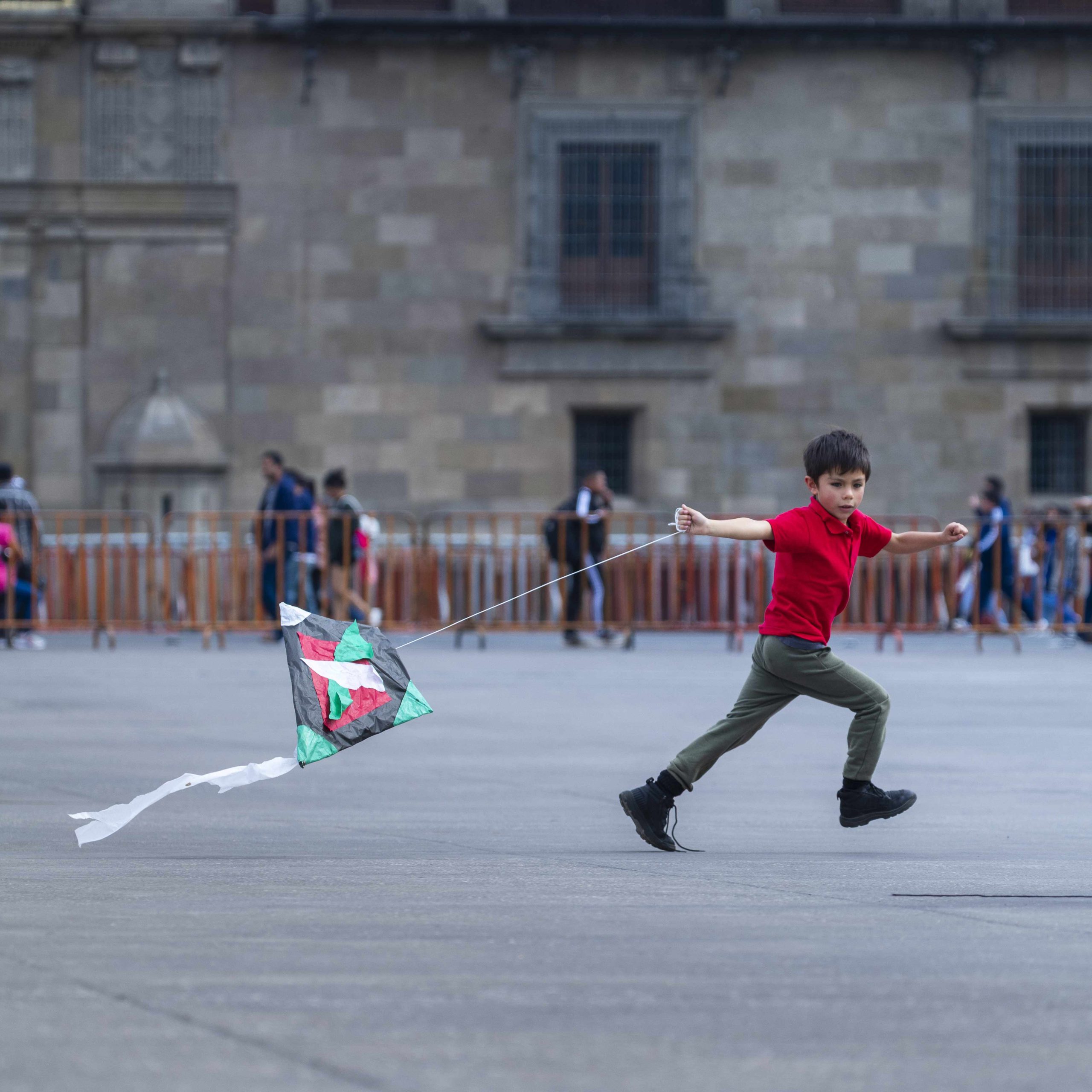
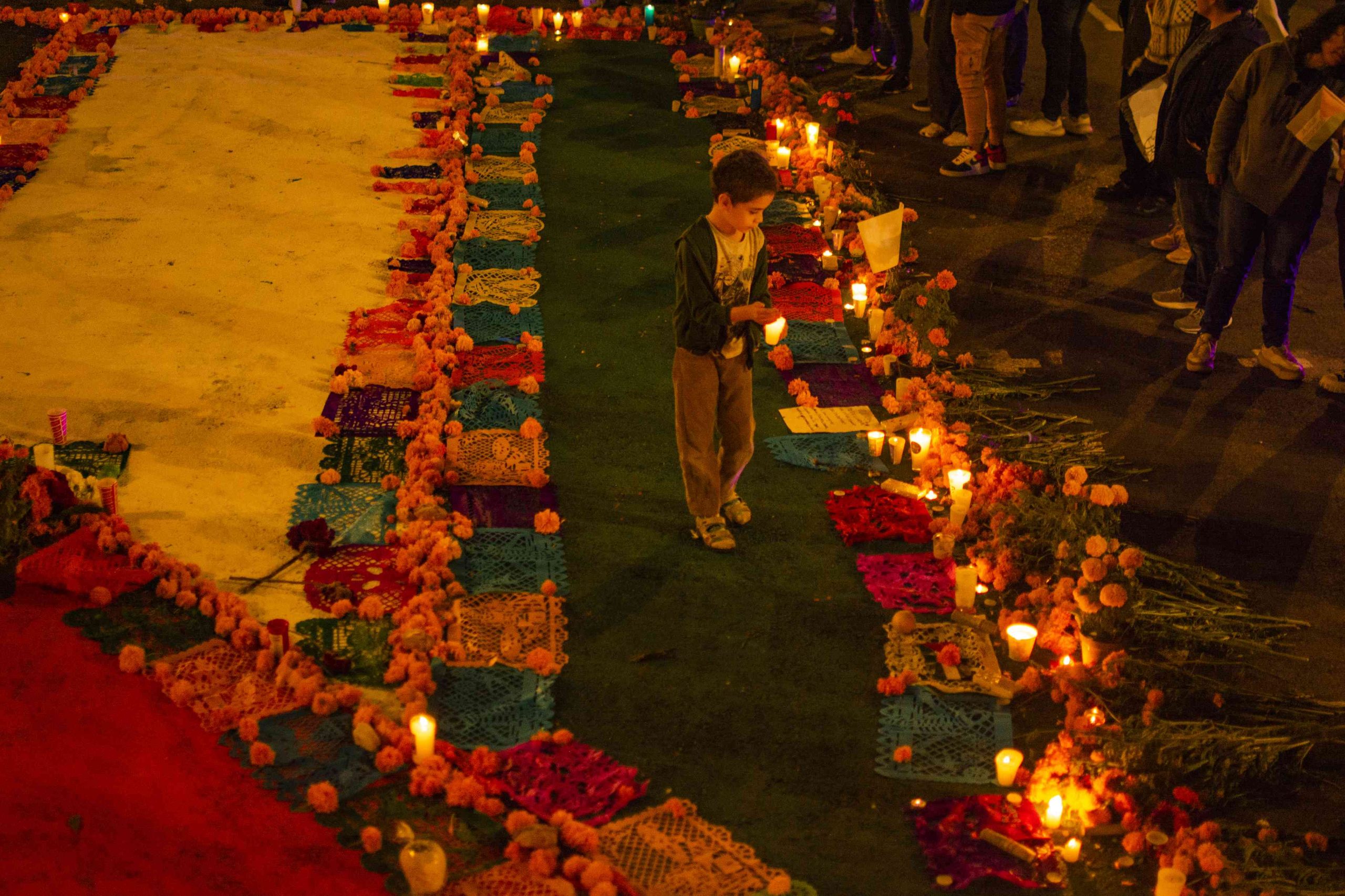
A light for Palestine
Sandra Suaste Avila, Mexico City, November 5, 2023.
A group of academics and activists demonstrate and offer cempasúchil flowers, candles, bread and the wish for an end to the violence in the Gaza Strip. Mexican women remember Palestinian women.
Stop genocide
Priscila Alexa Macías Mojica, Tijuana, Baja California, June 1, 2024.
Poster placed on the U.S.-Mexico border fence in a cross-border art and community activity.
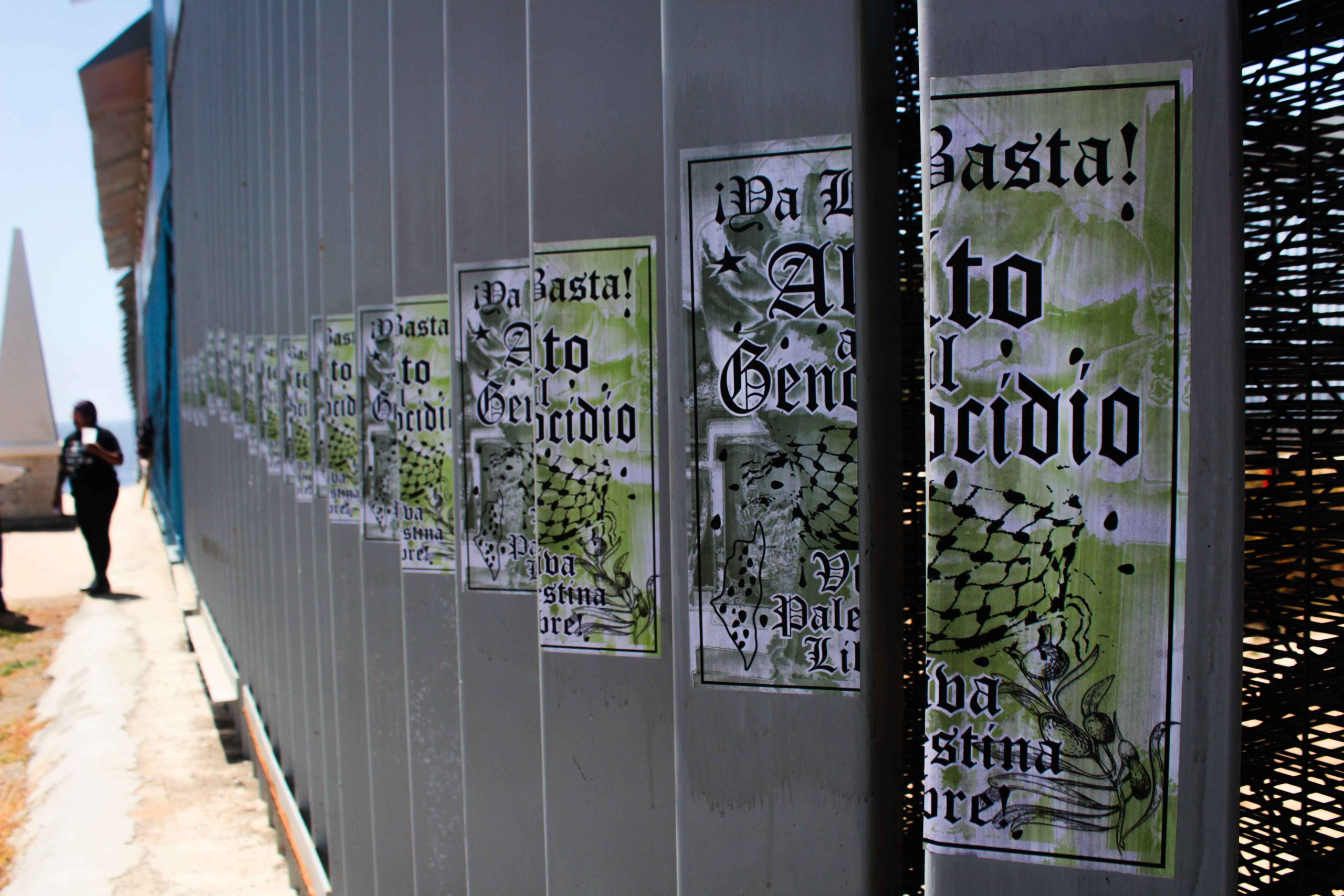
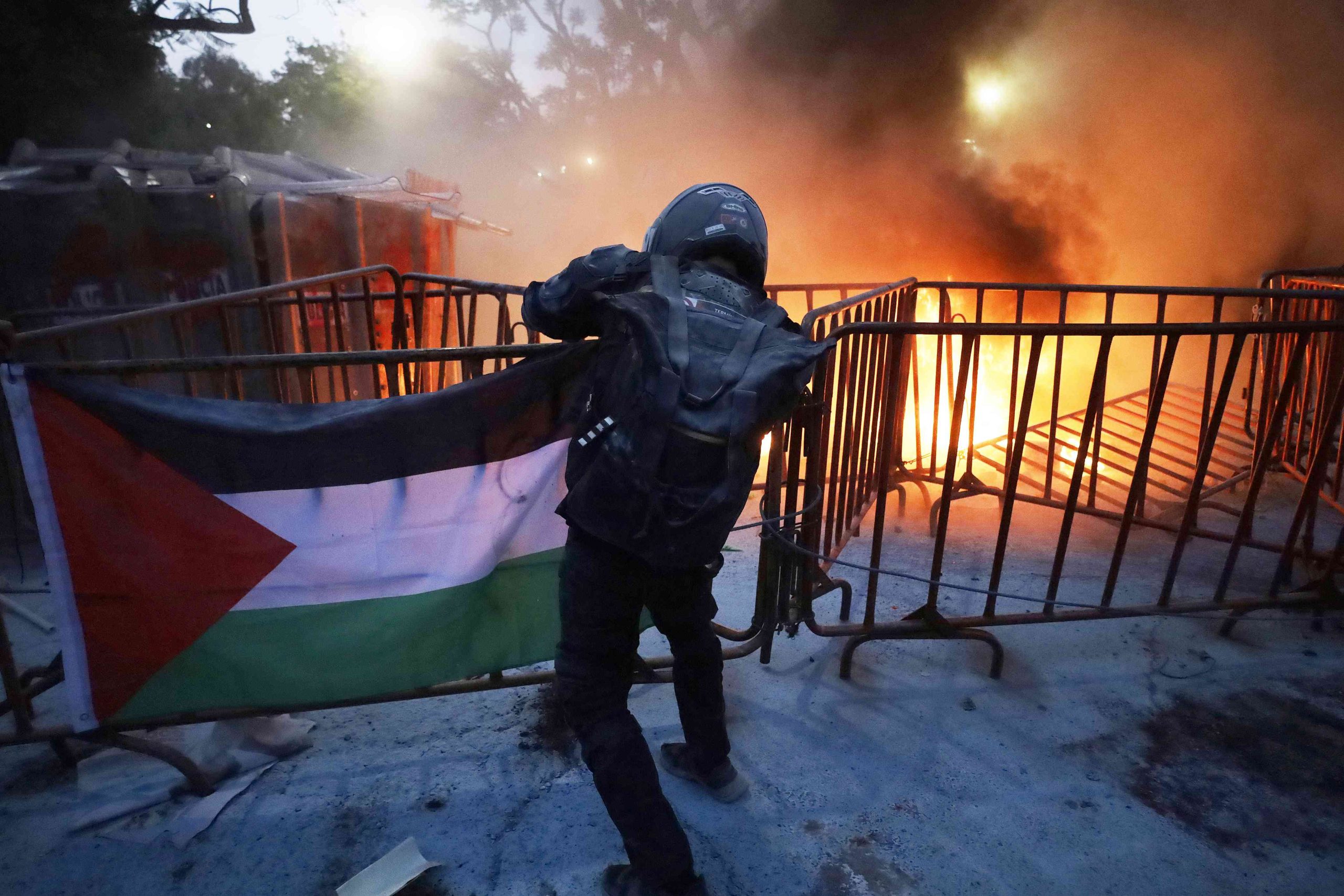
Global action for Rafah in Mexico
Gerardo Vieyra, Mexico City, May 28, 2024.
On Tuesday, May 28, 2024, students from various universities and social organizations in support of Palestine, demonstrated outside the Israeli Embassy in Mexico City, in rejection of the Israeli attacks that arrived that day to the center of Rafah, south of the Gaza Strip, the same day that Ireland, Spain and Norway recognized the State of Palestine and despite international condemnation for a bombing of a camp for displaced persons. According to data from human rights organizations, more than 46,000 people have died in Palestine and a large number of people have been wounded with serious health repercussions.
Looking down on the resistance from the 10th floor.
María Fernanda López López, UNAM Ciudad Universitaria, Mexico City, May 2024.
View of the encampment and monumental painting written on the esplanade of the central library of the UNAM, carried out by the members of the university student encampment in support of Palestine.
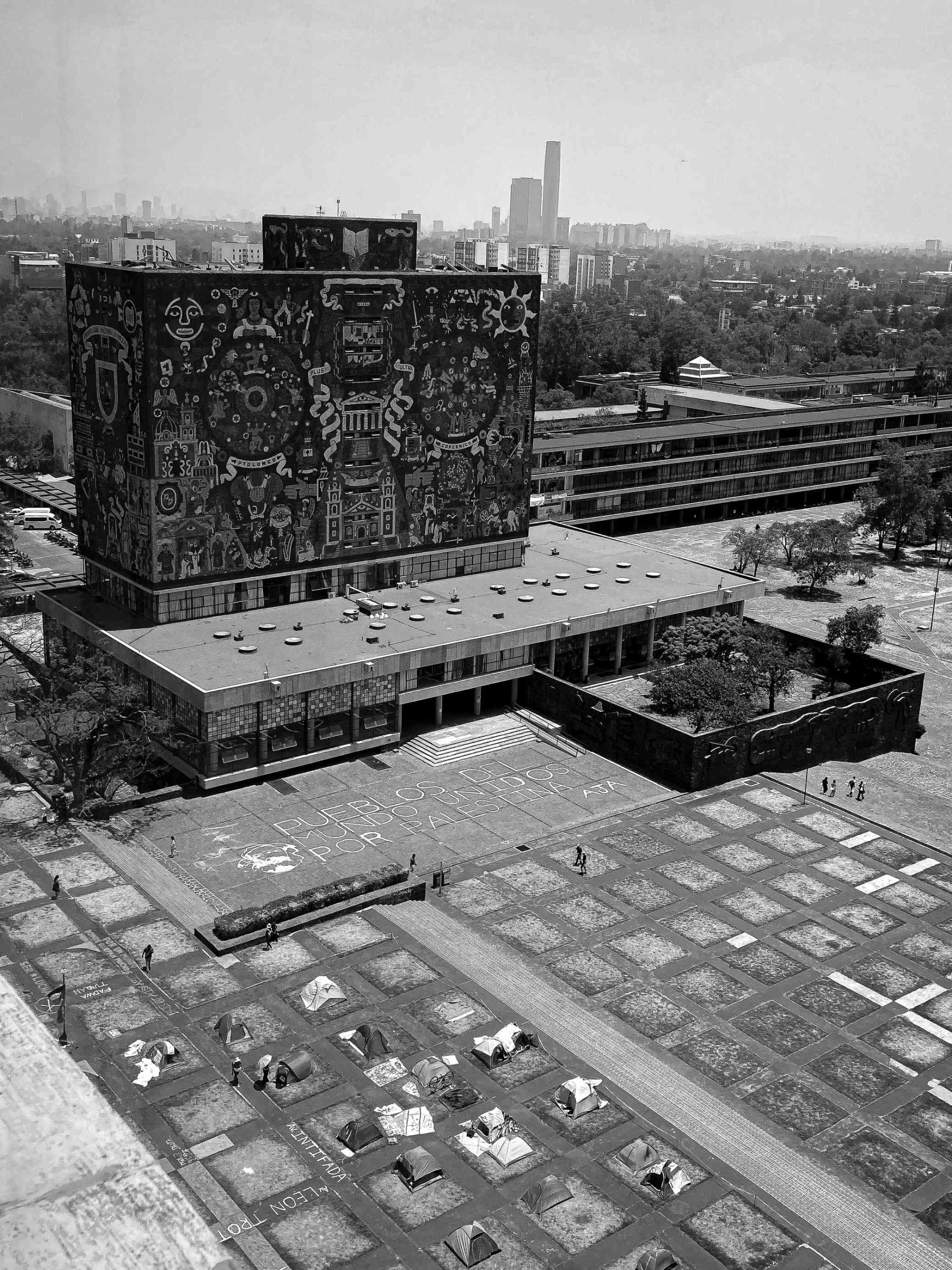
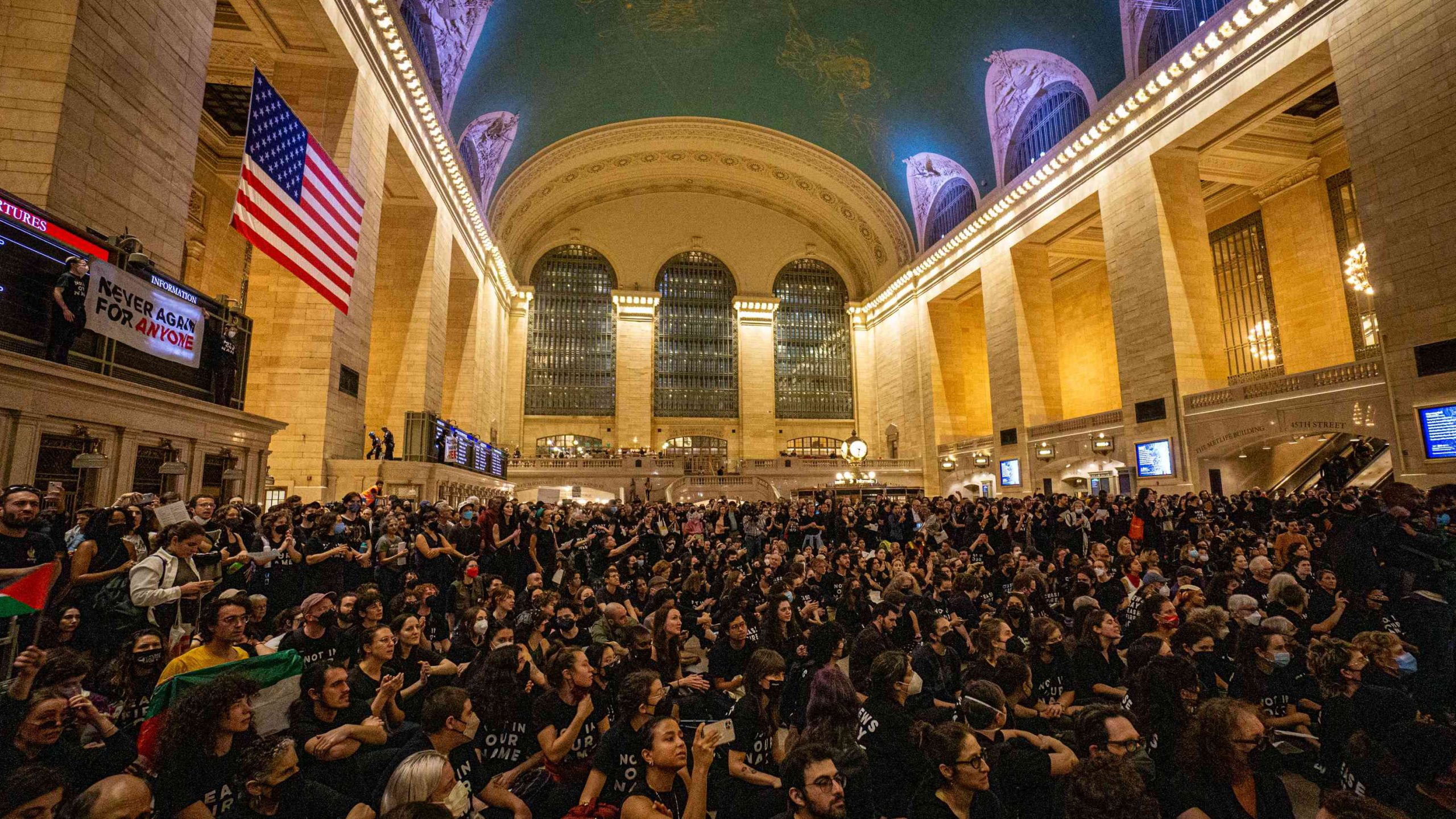
A break at Grand Central, no more war.
Charlie Ehrman, Manhattan, New York, October 27, 2023.
Hundreds of demonstrators from the Jewish Voice for Peace organization occupied the concourse of Grand Central Station in Manhattan, New York, to stop passenger traffic and demonstrate for a cease-fire in the conflict between Israel and Hamas.
March 8M CDMX
Elizabeth Sauno, Mexico City, March 8, 2024.
During the March 8 march in Mexico City, there were contingents in solidarity with Palestine, where sexual dissidents showed their support for the Palestinian cause.
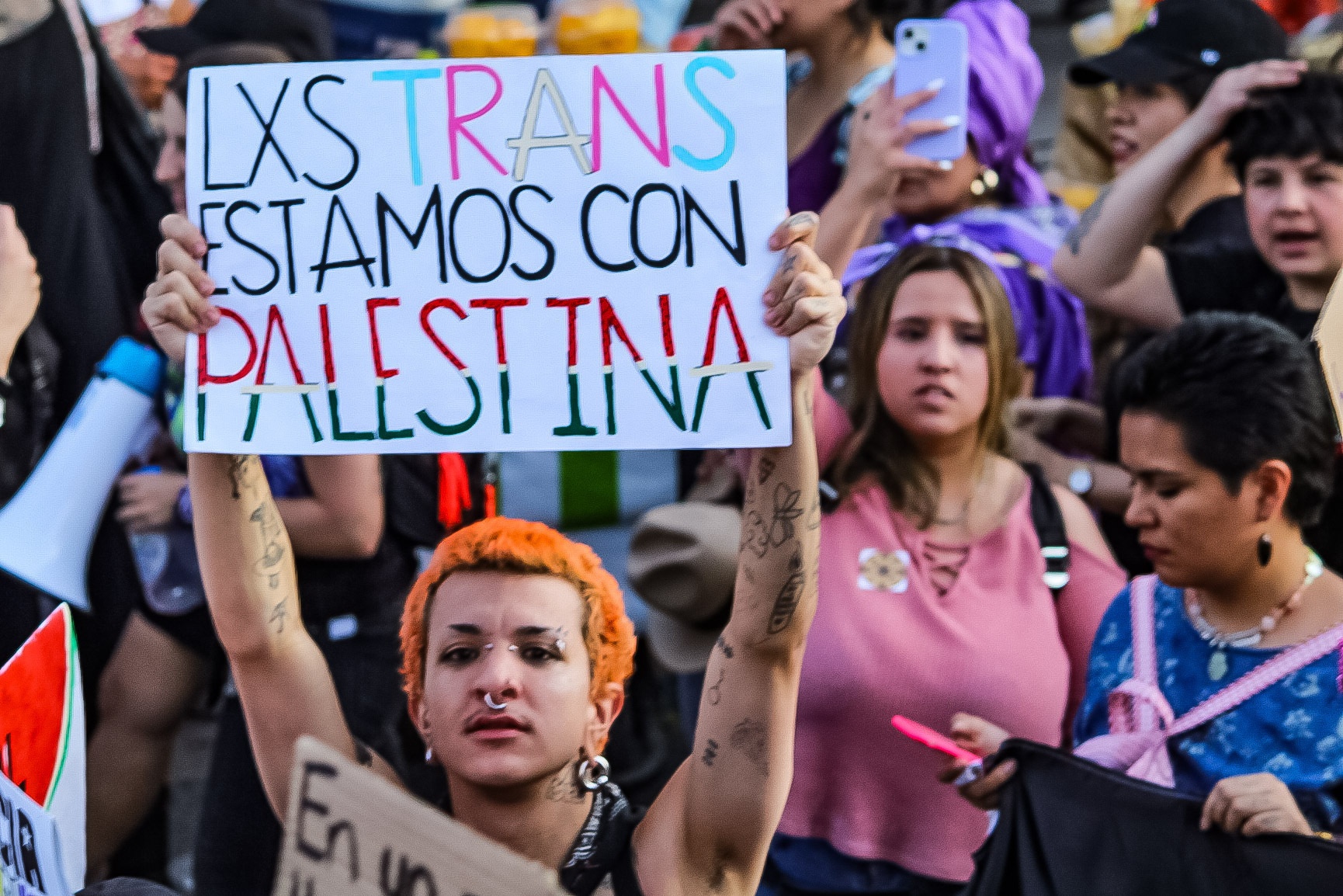
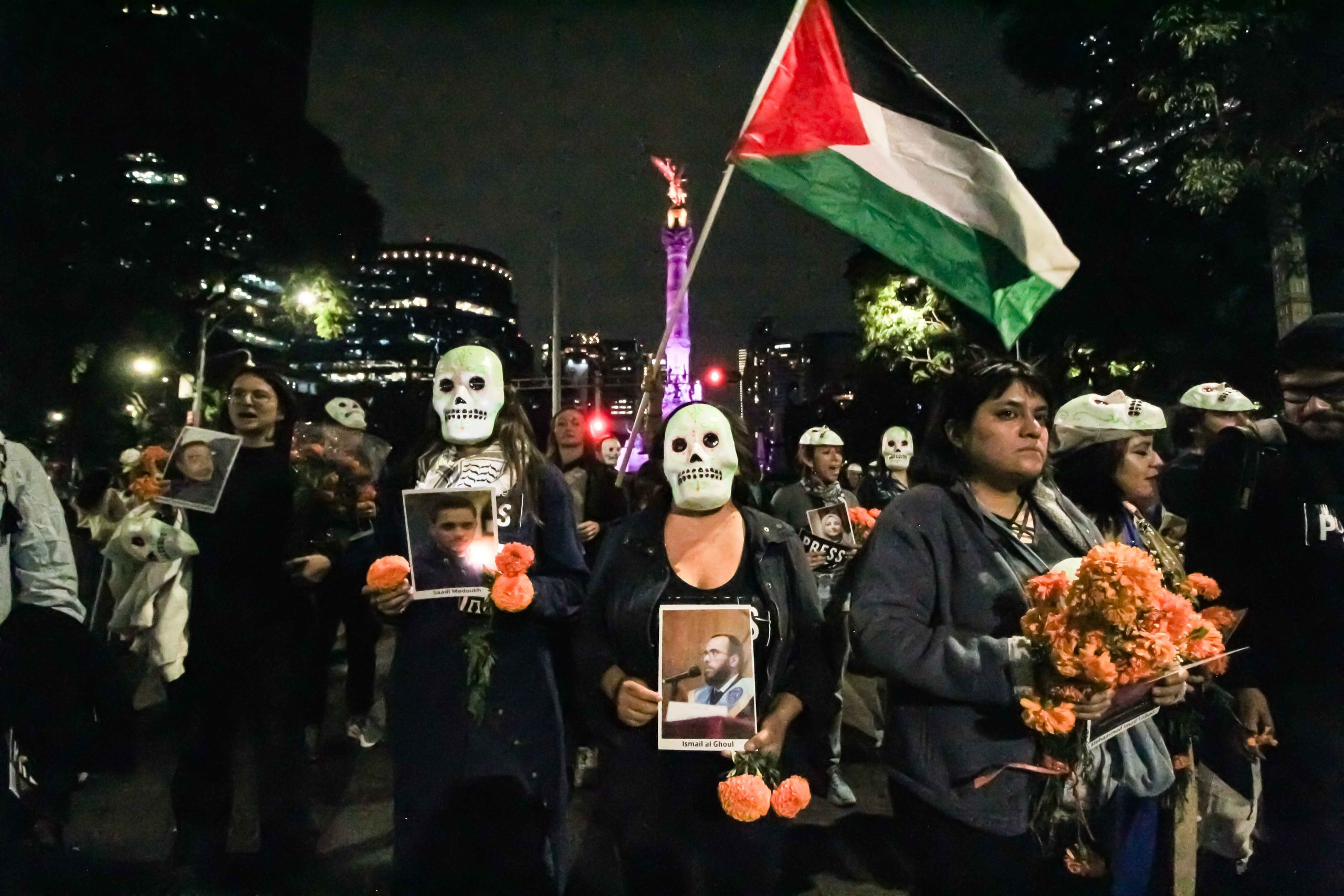
Day of the Dead CDMX 30 Oct 2024.
Elizabeth Sauno, October 30, 2024, Mexico City.
As part of the Day of the Dead, journalists gathered at the Angel of Independence to make visible the journalists who have lost their lives in the coverage of Israel's military escalation against the Palestinian people.
Stop genocide, a collective cry.
Ana Ivonne Rodríguez Anchondo, Mexico City, May 15, 2024.
Youth in front of police blockade at the Guardiola building, during the demonstrations for the 76th anniversary of the Palestinian Nakba, in Mexico City.

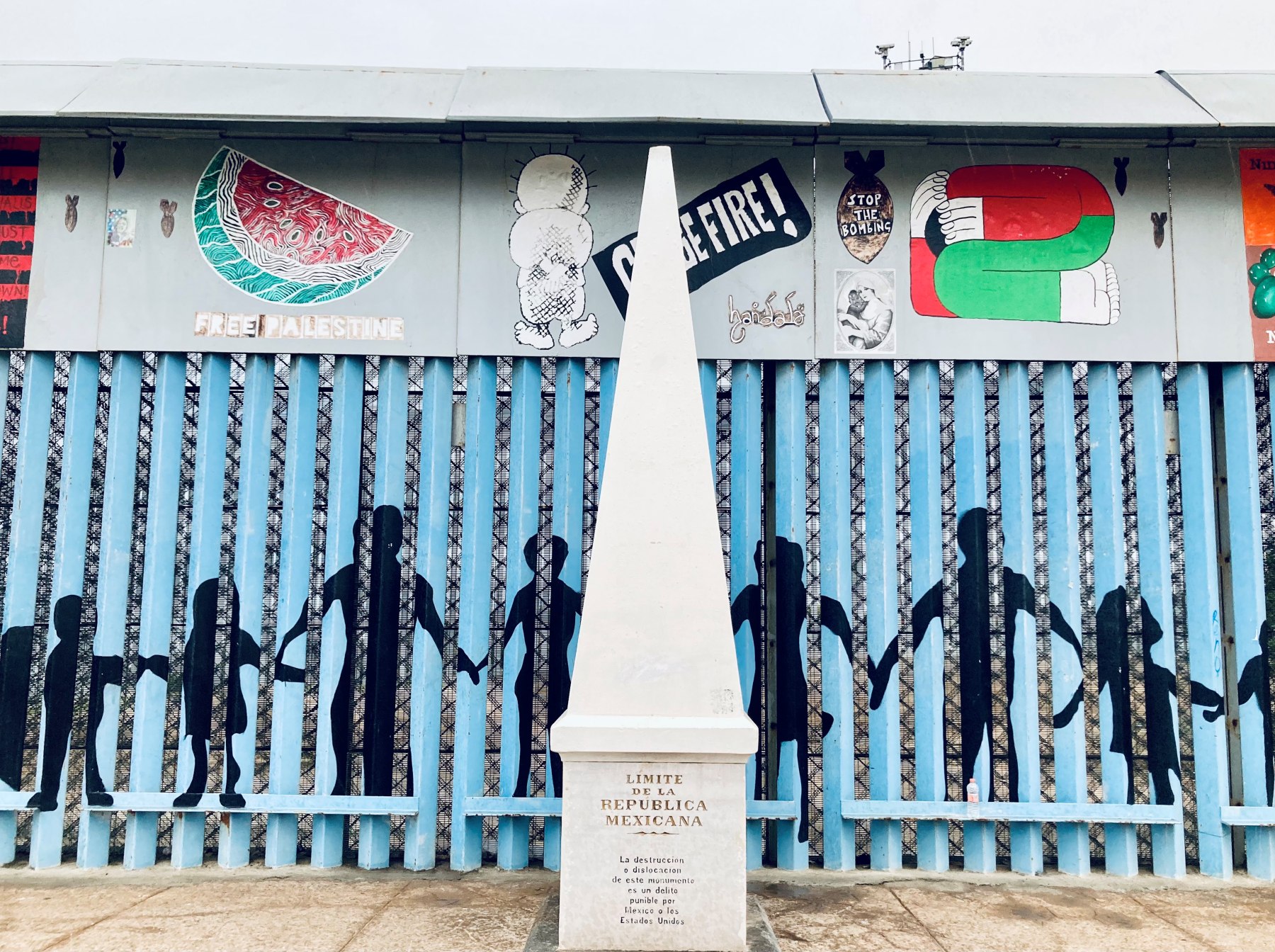
Handala in the corner of the world.
Marco Vinicio Morales Muñoz, Tijuana, Baja California, Mexico, February 13, 2025.
Handala, a symbol of the Palestinian people, is depicted on the Tijuana border wall along with other aesthetic elements and anti-war graphic designs that refer to the Israeli-Palestinian conflict.
Censorship in the media and shouting in the streets
Ilze Nava, Zócalo de la CDMX, February 17, 2024.
Demonstration for Free Palestine 2024.
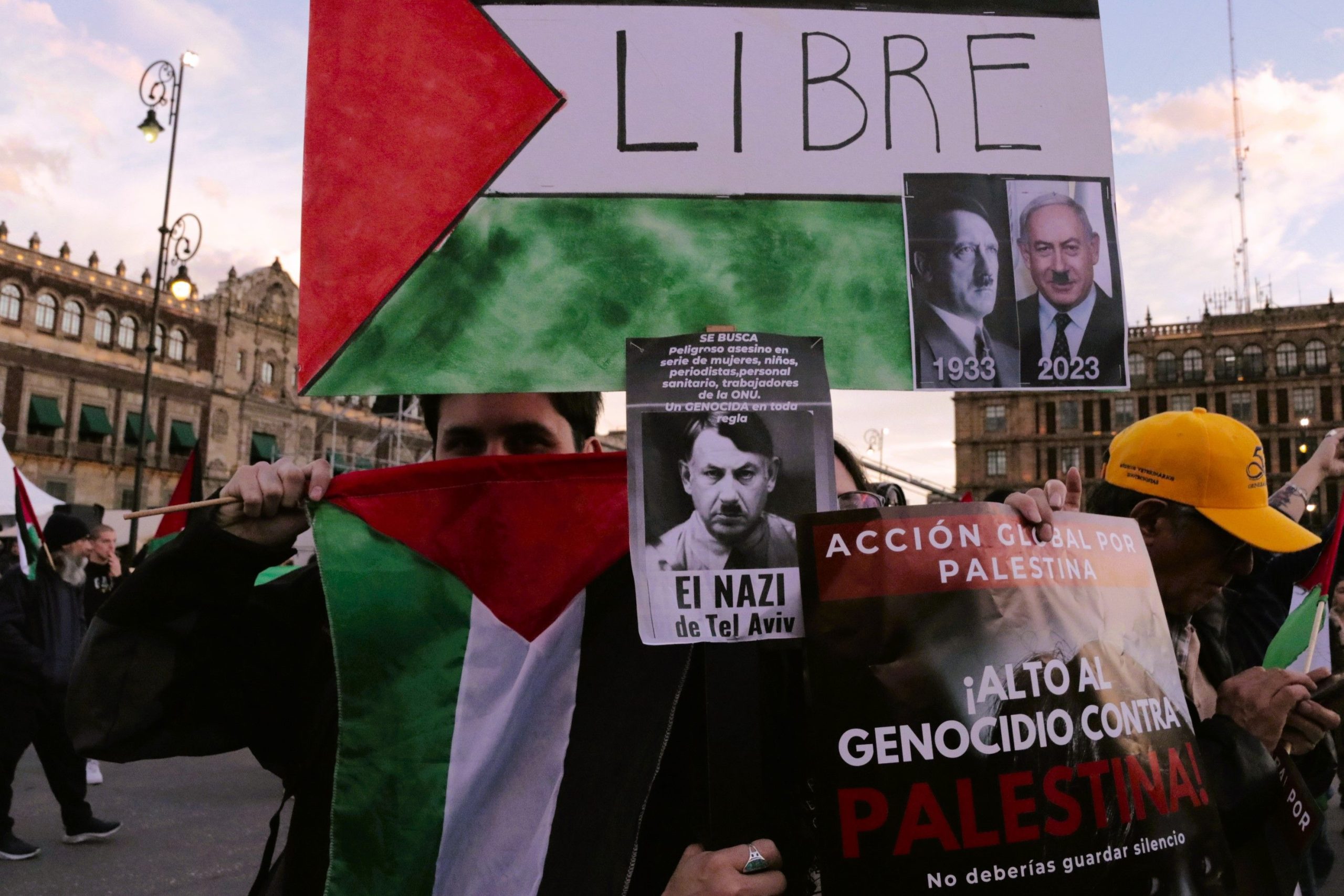
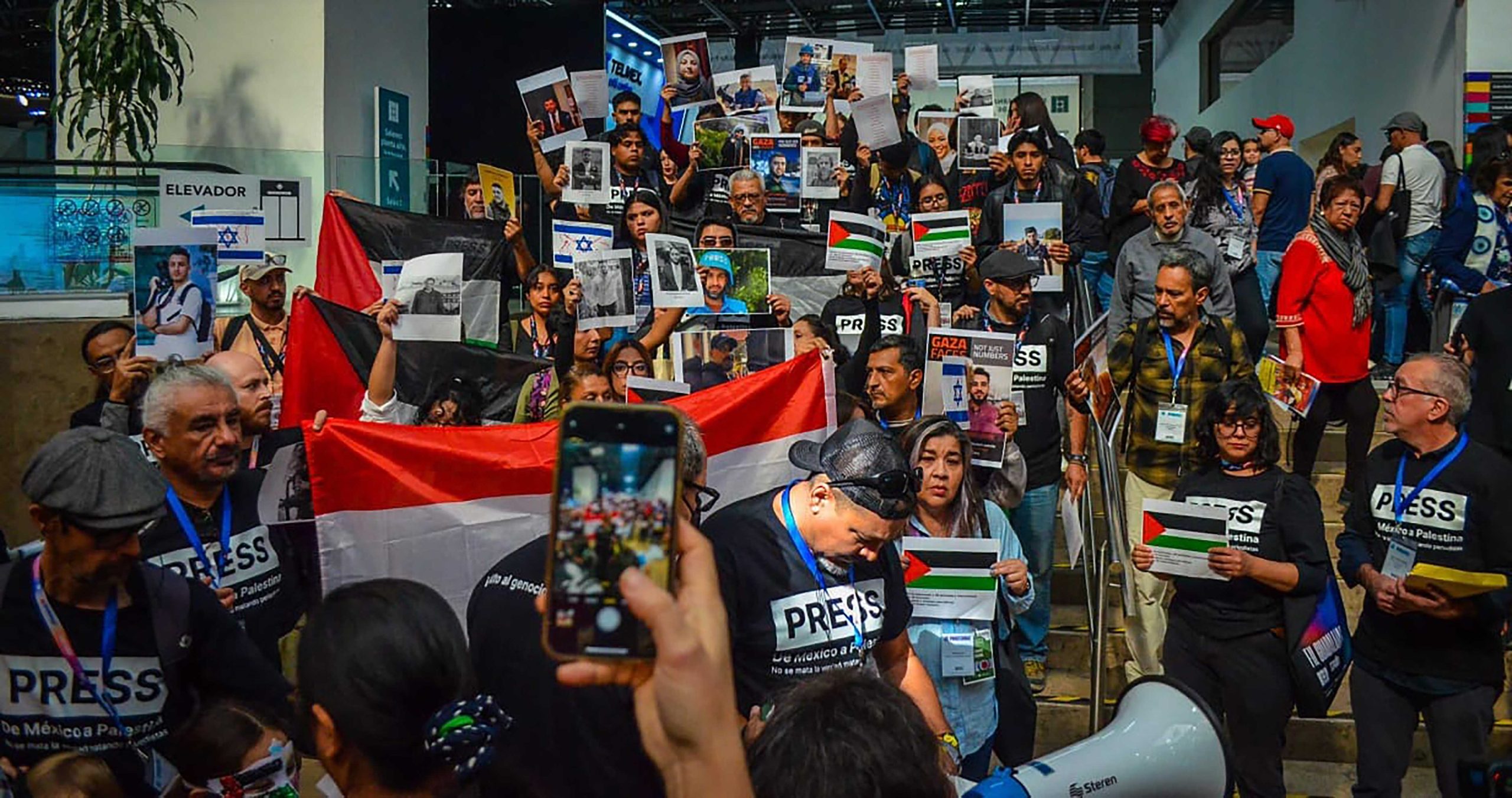
Journalists at FIL
Pilar Aranda, Expo, Guadalajara (FIL), December 5, 2024.
On the occasion of the XX International Meeting of Journalists, a protest was held in the vicinity of the International Book Fair in Guadalajara, it is reported that in the "conflict" there are close to 200 journalists murdered.
Bibliography
Anderson, Benedict (1993). Imagined communities. Reflections on the origin and spread of nationalism.. Mexico: FCE.
Bhabha, Homi K (2011). The place of culture. Buenos Aires: Spring.
Rancière, Jacques (2009). The distribution of the sensitive. Santiago de Chile: lom.
